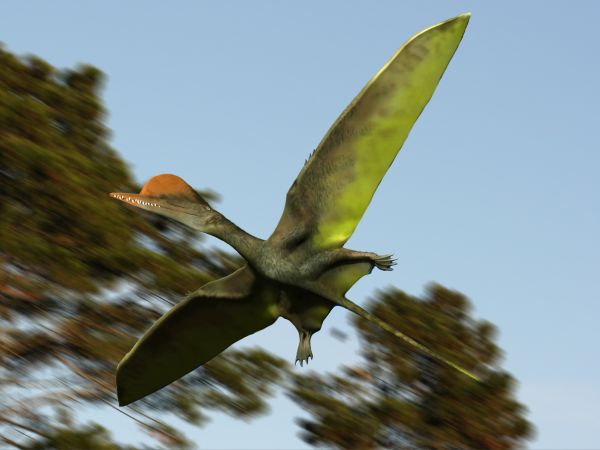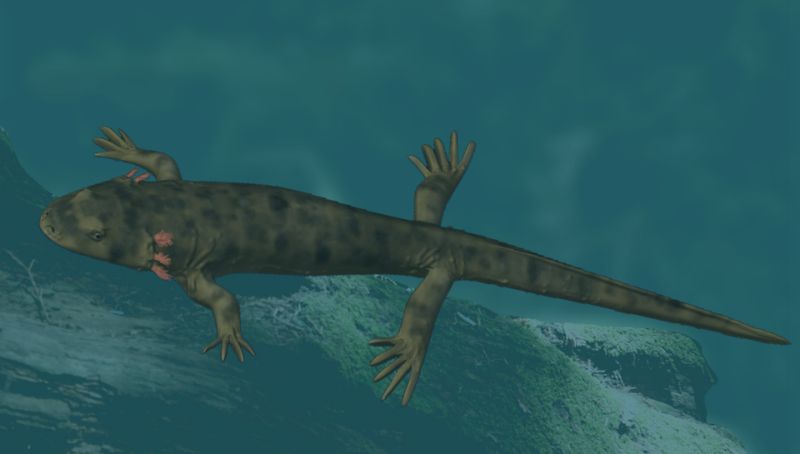|
Darwinopterus
''Darwinopterus'' (meaning "Darwin's wing") is a genus of pterosaur, discovered in China and named after biologist Charles Darwin. Between 30 and 40 fossil specimens have been identified, all collected from the Tiaojishan Formation, which dates to the middle Jurassic period, 160.89–160.25 Ma ago.Liu Y.-Q. Kuang H.-W., Jiang X.-J., Peng N., Xu H. & Sun H.-Y. (2012). "Timing of the earliest known feathered dinosaurs and transitional pterosaurs older than the Jehol Biota." ''Palaeogeography, Palaeoclimatology, Palaeoecology'' (advance online publication). The type species, type species, ''D. modularis'', was described in February 2010 in paleontology, 2010. ''D. modularis'' was the first known pterosaur to display features of both long-tailed (Rhamphorhynchoidea, rhamphorhynchoid) and short-tailed (Pterodactyloidea, pterodactyloid) pterosaurs, and was described as a transitional fossil between the two groups.Dell'Amore, C. (2009)"Odd New Pterosaur: 'Darwin's Wing' Fills Evolution Ga ... [...More Info...] [...Related Items...] OR: [Wikipedia] [Google] [Baidu] |
Darwinopterus NT
''Darwinopterus'' (meaning "Darwin's wing") is a genus of pterosaur, discovered in China and named after biologist Charles Darwin. Between 30 and 40 fossil specimens have been identified, all collected from the Tiaojishan Formation, which dates to the middle Jurassic period, 160.89–160.25 Ma ago.Liu Y.-Q. Kuang H.-W., Jiang X.-J., Peng N., Xu H. & Sun H.-Y. (2012). "Timing of the earliest known feathered dinosaurs and transitional pterosaurs older than the Jehol Biota." ''Palaeogeography, Palaeoclimatology, Palaeoecology'' (advance online publication). The type species, type species, ''D. modularis'', was described in February 2010 in paleontology, 2010. ''D. modularis'' was the first known pterosaur to display features of both long-tailed (Rhamphorhynchoidea, rhamphorhynchoid) and short-tailed (Pterodactyloidea, pterodactyloid) pterosaurs, and was described as a transitional fossil between the two groups.Dell'Amore, C. (2009)"Odd New Pterosaur: 'Darwin's Wing' Fills Evolution Ga ... [...More Info...] [...Related Items...] OR: [Wikipedia] [Google] [Baidu] |
Pterosaur
Pterosaurs (; from Greek ''pteron'' and ''sauros'', meaning "wing lizard") is an extinct clade of flying reptiles in the order, Pterosauria. They existed during most of the Mesozoic: from the Late Triassic to the end of the Cretaceous (228 to 66 million years ago). Pterosaurs are the earliest vertebrates known to have evolved powered flight. Their wings were formed by a membrane of skin, muscle, and other tissues stretching from the ankles to a dramatically lengthened fourth finger. There were two major types of pterosaurs. Basal pterosaurs (also called 'non-pterodactyloid pterosaurs' or 'rhamphorhynchoids') were smaller animals with fully toothed jaws and, typically, long tails. Their wide wing membranes probably included and connected the hind legs. On the ground, they would have had an awkward sprawling posture, but the anatomy of their joints and strong claws would have made them effective climbers, and some may have even lived in trees. Basal pterosaurs were insectiv ... [...More Info...] [...Related Items...] OR: [Wikipedia] [Google] [Baidu] |
Lü Junchang
Lü Junchang (; 1965 – 9 October 2018) was a Chinese palaeontologist and professor at the Institute of Geology, Chinese Academy of Geological Sciences. An expert on Mesozoic reptiles, he described and named dozens of dinosaur and pterosaur taxa including ''Tongtianlong'', ''Qianzhousaurus'', ''Heyuannia'', '' Gannansaurus'', ''Yunnanosaurus youngi'', and ''Darwinopterus.'' Biography Lü was born in 1965. He graduated from Lanzhou University in 1989 with a bachelor's degree in geology. He studied at the Institute of Vertebrate Paleontology and Paleoanthropology (IVPP) of the Chinese Academy of Sciences from 1997 to 2000 and earned his master's degree. He subsequently went to the United States to study at the Department of Earth Sciences at the Southern Methodist University, earning his Ph.D. in 2004. Lü began working for the Chinese Academy of Geological Sciences in July 2004, initially as a postdoctoral researcher, then as associate professor and eventually as professor and ... [...More Info...] [...Related Items...] OR: [Wikipedia] [Google] [Baidu] |
Wukongopteridae
Wukongopteridae is a group of basal pterosaurs, found in China and the UK. It contains eight species in five genera, all dated to the Middle to Late Jurassic period, The Wukongopteridae were first named by Wang ''et al.'' in 2009, not yet giving an exact definition.* The clade Wukongopteridae was first defined by Wang ''et al.'' in 2010 as "the most recent common ancestor of '' Wukongopterus lii'' and '' Kunpengopterus sinensis'', and all of its descendants". Description Wukongopterids are characterized by a unique combination of "primitive" and advanced pterosaurian features. While they had long tails and other features characteristic of other "rhamphorhynchoids", they also had distinct pterodactyloid features, such as long vertebrae in the neck and a single skull opening in front of the eyes, the nasoantorbital fenestra (in most "rhamphorhynchoids", the antorbital fenestra and the nasal opening are separate). This feature lead to ''Darwinopterus modularis'' being placed by L ... [...More Info...] [...Related Items...] OR: [Wikipedia] [Google] [Baidu] |
Tiaojishan Formation
The Tiaojishan Formation is a geological formation in Hebei and Liaoning, People's Republic of China, dating to the middle-late Jurassic period (Bathonian- Oxfordian stages). It is known for its exceptionally preserved fossils, including those of plants, insects and vertebrates. It is made up mainly of pyroclastic rock interspersed with basic volcanic and sedimentary rocks. Previously, the Tiaojishan Formation was grouped together with the underlying Haifanggou Formation (also known as the Jiulongshan Formation) as a single "Lanqi Formation." The Tiaojishan Formation forms a key part of the Yanliao Biota assemblage, alongside the Haifanggou Formation. Age Using Argon–argon dating, Wang and colleagues in 2005 dated part of the Tiaojishan Formation to about 160 million years ago, the beginning of the Oxfordian stage, the first stage of the Upper Jurassic epoch. In 2006, a study by Liu and colleagues used U-Pb zircon dating to conclude that the Tiaojishan Formation correlates wi ... [...More Info...] [...Related Items...] OR: [Wikipedia] [Google] [Baidu] |
Kunpengopterus
''Kunpengopterus'' is a genus of wukongopterid pterosaur from the middle-late Jurassic Tiaojishan Formation of northeastern China. The genus contains two species, the type species ''K. sinensis'' and ''K. antipollicatus''. History of discovery ''K. sinensis'' is known from the holotype specimen IVPP V16047, an almost complete skeleton with complete skull and lower jaws recovered from rocks of the Tiaojishan Formation or Daohugou Beds in Linglongta, Jianchang County, western Liaoning. The age of these layers is controversial. This compression fossil is of an adult individual. Aside from the bones some soft parts were also preserved and the remains of a possibly regurgitated fish. ''Kunpengopterus'' was named and described by Wang Xiaolin, Alexander Wilhelm Armin Kellner, Jiang Shunxing, Cheng Xin, Meng Xi and Taissa Rodrigues in 2010. The type species is ''Kunpengopterus sinensis''. The generic name combines the Kun, a large fish or whale from Chinese folklore that could t ... [...More Info...] [...Related Items...] OR: [Wikipedia] [Google] [Baidu] |
Dinosaur
Dinosaurs are a diverse group of reptiles of the clade Dinosauria. They first appeared during the Triassic period, between 243 and 233.23 million years ago (mya), although the exact origin and timing of the evolution of dinosaurs is the subject of active research. They became the dominant terrestrial vertebrates after the Triassic–Jurassic extinction event 201.3 mya; their dominance continued throughout the Jurassic and Cretaceous periods. The fossil record shows that birds are feathered dinosaurs, having evolved from earlier theropods during the Late Jurassic epoch, and are the only dinosaur lineage known to have survived the Cretaceous–Paleogene extinction event approximately 66 mya. Dinosaurs can therefore be divided into avian dinosaurs—birds—and the extinct non-avian dinosaurs, which are all dinosaurs other than birds. Dinosaurs are varied from taxonomic, morphological and ecological standpoints. Birds, at over 10,700 living species, are among ... [...More Info...] [...Related Items...] OR: [Wikipedia] [Google] [Baidu] |
Ceratopsia
Ceratopsia or Ceratopia ( or ; Greek: "horned faces") is a group of herbivorous, beaked dinosaurs that thrived in what are now North America, Europe, and Asia, during the Cretaceous Period, although ancestral forms lived earlier, in the Jurassic. The earliest known ceratopsian, ''Yinlong downsi'', lived between 161.2 and 155.7 million years ago.Holtz, Thomas R. Jr. (2011) ''Dinosaurs: The Most Complete, Up-to-Date Encyclopedia for Dinosaur Lovers of All Ages,'Winter 2010 Appendix./ref> The last ceratopsian species, ''Triceratops prorsus'', became extinct during the Cretaceous–Paleogene extinction event, . ''Triceratops'' is by far the best-known ceratopsian to the general public. It is traditional for ceratopsian genus names to end in "''-ceratops''", although this is not always the case. One of the first named genera was ''Ceratops'' itself, which lent its name to the group, although it is considered a '' nomen dubium'' today as its fossil remains have no distinguishing charact ... [...More Info...] [...Related Items...] OR: [Wikipedia] [Google] [Baidu] |
Kevin Padian
Kevin Padian (born 1951) is a Professor of Integrative Biology at the University of California, Berkeley, Curator of Paleontology, University of California Museum of Paleontology and was President of the National Center for Science Education from 2007 to 2008. Padian's area of interest is in vertebrate evolution, especially the origins of flight and the evolution of birds from theropod dinosaurs. He served as an expert witness for the plaintiffs in the ''Kitzmiller v. Dover Area School District'' trial, and his testimony was repeatedly cited in the court's decision. Padian received a bachelor's degree in Natural Science and a Master of Arts degree in Teaching from Colgate University, and a Ph.D. from Yale University, where he focused on the evolution of flight in pterosaurs. He subsequently became interested in paleobiology, especially using paleohistology. He developed this research program in collaboration with Armand de Ricqlès and Jack Horner. In addition to his work at ... [...More Info...] [...Related Items...] OR: [Wikipedia] [Google] [Baidu] |
Pterodactyloid
Pterodactyloidea (derived from the Greek words ''πτερόν'' (''pterón'', for usual ''ptéryx'') "wing", and ''δάκτυλος'' (''dáktylos'') "finger" meaning "winged finger", "wing-finger" or "finger-wing") is one of the two traditional suborders of pterosaurs ("wing lizards"), and contains the most derived members of this group of flying reptiles. They appeared during the middle Jurassic Period, and differ from the basal (though paraphyletic) rhamphorhynchoids by their short tails and long wing metacarpals (hand bones). The most advanced forms also lack teeth, and by the late Cretaceous, all known pterodactyloids were toothless. Many species had well-developed crests on the skull, a form of display taken to extremes in giant-crested forms like ''Nyctosaurus'' and ''Tupandactylus''. Pterodactyloids were the last surviving pterosaurs when the order became extinct at the end of the Cretaceous Period, together with the non-avian dinosaurs and most marine reptiles. "Pteroda ... [...More Info...] [...Related Items...] OR: [Wikipedia] [Google] [Baidu] |
Zhejiang Museum Of Natural History
The Zhejiang Museum of Natural History is a museum that mainly focuses on exhibitions, collections and analysis on specimens of life science and earth science. The museum is one of the earliest museums of natural history created by Chinese people.Museum General Information ''ZMNH'', 2009. Retrieved November 11th, 2016. See also *List of museums in China
, there are 3,589 museums in China, including 3,054 state-owned museums (museums run by national and local government or universities) and 535 private museums. With a total collection of over 20 million items, these museums hold more than 8,000 e ...
Ref ...
|
Sexual Dimorphism
Sexual dimorphism is the condition where the sexes of the same animal and/or plant species exhibit different morphological characteristics, particularly characteristics not directly involved in reproduction. The condition occurs in most animals and some plants. Differences may include secondary sex characteristics, size, weight, colour, markings, or behavioural or cognitive traits. These differences may be subtle or exaggerated and may be subjected to sexual selection and natural selection. The opposite of dimorphism is ''monomorphism'', which is when both biological sexes are phenotypically indistinguishable from each other. Overview Ornamentation and coloration Common and easily identified types of dimorphism consist of ornamentation and coloration, though not always apparent. A difference in coloration of sexes within a given species is called sexual dichromatism, which is commonly seen in many species of birds and reptiles. Sexual selection leads to the exaggerated dim ... [...More Info...] [...Related Items...] OR: [Wikipedia] [Google] [Baidu] |






